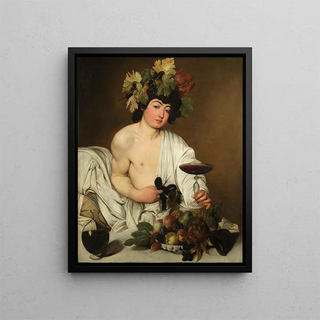Art print | Bacchus - Caravaggio


View from behind

Frame (optional)
In the fascinating universe of art history, some works transcend time and space, captivating the eye and mind of viewers across ages. "Bacchus - The Caravaggio" is one of these iconic pieces, a celebration of wine, festivity, and human exuberance. This painting, created by Michelangelo Merisi da Caravaggio, immerses us in a world where the divine and the profane meet, where shadow and light intertwine to reveal the complexity of human nature. Through this artwork, The Caravaggio invites us to explore the pleasures and excesses of life, while confronting our own demons.
Style and uniqueness of the work
The style of Caravaggio is unmatched, characterized by striking realism and bold use of chiaroscuro. In "Bacchus," this technique reaches its peak, creating an atmosphere that is both intimate and dramatic. The central figure, Bacchus, is depicted with palpable humanity, far from classical idealizations. His relaxed posture, enchanting gaze, and meticulous details of his flesh evoke a disturbing sensuality. The fruits and wine, symbolic elements of celebration, are rendered with such precision that they seem almost tangible. The contrast between the light illuminating Bacchus's face and the shadows surrounding him reinforces the idea of duality, pleasure and danger, ecstasy and self-loss.
The artist and his influence
Michelangelo Merisi da Caravaggio, an emblematic figure of the Baroque, revolutionized the art world with his innovative approach. Born in Milan in 1571, he captured the essence of everyday life while incorporating religious and mythological themes. His influence extends far beyond his era, inspiring generations of artists to explore realism and raw emotion. Caravaggio knew how to give a voice to the marginalized, the forgotten, and "Bacchus" is a perfect illustration of this. By depicting the god of wine in a human and accessible light, he challenged the conventions of his time, posing the

Matte finish

View from behind

Frame (optional)
In the fascinating universe of art history, some works transcend time and space, captivating the eye and mind of viewers across ages. "Bacchus - The Caravaggio" is one of these iconic pieces, a celebration of wine, festivity, and human exuberance. This painting, created by Michelangelo Merisi da Caravaggio, immerses us in a world where the divine and the profane meet, where shadow and light intertwine to reveal the complexity of human nature. Through this artwork, The Caravaggio invites us to explore the pleasures and excesses of life, while confronting our own demons.
Style and uniqueness of the work
The style of Caravaggio is unmatched, characterized by striking realism and bold use of chiaroscuro. In "Bacchus," this technique reaches its peak, creating an atmosphere that is both intimate and dramatic. The central figure, Bacchus, is depicted with palpable humanity, far from classical idealizations. His relaxed posture, enchanting gaze, and meticulous details of his flesh evoke a disturbing sensuality. The fruits and wine, symbolic elements of celebration, are rendered with such precision that they seem almost tangible. The contrast between the light illuminating Bacchus's face and the shadows surrounding him reinforces the idea of duality, pleasure and danger, ecstasy and self-loss.
The artist and his influence
Michelangelo Merisi da Caravaggio, an emblematic figure of the Baroque, revolutionized the art world with his innovative approach. Born in Milan in 1571, he captured the essence of everyday life while incorporating religious and mythological themes. His influence extends far beyond his era, inspiring generations of artists to explore realism and raw emotion. Caravaggio knew how to give a voice to the marginalized, the forgotten, and "Bacchus" is a perfect illustration of this. By depicting the god of wine in a human and accessible light, he challenged the conventions of his time, posing the






